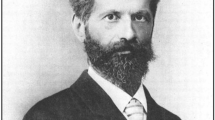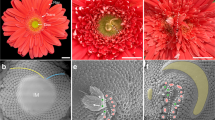Summary
-
1.
Isolated single cells of the basal part of the gemma of Riella helicophylla regenerate to whole plants. Late developmental stages of rhizoid initials divide earlier after isolation than young rhizoid initials and “normal cells” of the basal part.
-
2.
In isolated groups of two cells composed of one rhizoid initial and one “normal cell” only the rhizoid initial divides, and it divides much sooner than it does as a single cell.
-
3.
If in isolated groups of two cells from the basal part of the gemma the divided cell is killed immediately after division, the second cell of the group also divides, just as soon, in fact, as it would have if it had been isolated as a single cell. If the first divided cell is killed 7 days after division, the division of the second cell of the group is delayed by 6 days.
-
4.
After isolation of single cells and of small groups of cells from old as well as from young tissue of the wing, cell division occurs earliest in the largest cell groupe and latest in single cells. The regenerates develop the more quickly the larger the isolated cell group from which they derive.
-
5.
Cells in fragments isolated from young tissue divide sooner after isolation than cells in fragments from old tissue. However, single cells isolated from old tissue divide earlier than single cells from young tissue.
-
6.
Light is a prerequisite for regeneration of single cells and of small groups of cells from the marginal region of the wing. Only in relatively large tissue fragments do some cells also divide in the dark.
-
7.
The existence and nature of correlations between the cells of a regenerating tissue fragment are discussed.
Zusammenfassung
-
1.
Isolierte Einzelzellen des Brutkörperstiels von Riella helicophylla regenerieren zu ganzen Pflanzen. Späte Entwicklungsstadien von Rhizoidinitialen kommen nach Auslösung der Regeneration schneller zur Teilung als junge Rhizoidinitialen und normale Stielzellen.
-
2.
In regenerierenden Zwei-Zell-Verbänden, die aus einer Rhizoidinitiale und einer normalen Stielzelle bestehen, kommt immer nur die Rhizoidinitiale zur Teilung, und zwar wesentlich schneller als Einzelzelle.
-
3.
Tötet man in regenerierenden Zwei-Zell-Verbänden aus dem Stiel des Brutkörpers die geteilte Zelle sofort nach ihrer Teilung ab, so kommt die zweite Zelle des Verbandes auch zur Teilung, und zwar ebenso schnell, wie wenn sie von Auslösung der Regeneration an als Einzelzelle vorgelegen hätte. Tötet man die zuerst geteilte Zelle 7 Tage nach ihrer Teilung ab, so kommt die zweite Zelle des Verbandes mit 6 Tagen Verzögerung zur Teilung.
-
4.
Nach Isolierung von Einzelzellen und kleinen Zellverbänden aus sowohl altem als auch jungem Flügelgewebe treten Zellteilungen in den jeweils größten Zellverbänden am frühesten, in Einzelzellen am spätesten auf. Die Entwicklung der Regenerate verläuft um so schneller, je größer die Zellverbände sind, aus denen sie entstehen.
-
5.
In Fragmenten aus jungem Gewebe kommt es schneller nach Auslösung der Regeneration zu Zellteilungen als in Fragmenten aus altem Gewebe. Dagegen teilen sich nach Isolierung Einzelzellen aus altem Gewebe eher als Einzelzellen aus jungem Gewebe.
-
6.
Das Licht ist für die Regeneration isolierter Einzelzellen und kleiner Zellverbände aus der Randzone des Flügelgewebes notwendige Voraussetzung. Nur in relativ großen Fragmenten kommt es auch im Dunkeln zu Zellteilungen.
-
7.
Es wird über die Existenz und die Natur der Korrelationen zwischen den Zellen eines regenerierenden Zellverbandes diskutiert.
Similar content being viewed by others
Literatur
Earle, E. D., and J. G. Torrey: Colony formation by isolated Convolvulus cells plated on defined media. Plant Physiol. 40, 520–528 (1965).
Goebel, K.: Archegoniatenstudien XI. Weitere Untersuchungen über Keimung und Regeneration bei Riella und Sphaerocarpus. Flora (Jena) 97, 192–215 (1907).
Goebel, K.: Organographie der Pflanzen, Bd. II. Jena 1930.
Harte, C., u. J. Pfanzagl: Biomet. Z. im Druck (1966).
Ito, M.: Studies on the differentiation of fern gametophytes I. Regeneration of single cells isolated from cordate gametophytes of Pteris vittata. Bot. Mag. (Kokyo) 75, 19–27 (1962).
Karsten, I.: Über den Einfluß äußerer Faktoren auf die Embryonalisierung differenzierter Zellen von Riella helicophylla. Diss. Köln 1965.
Kato, H., and M. Takeuchi: Morphogenesis in vitro starting from single cells of carrot root. Plant and Cell Physiol. 4, 243–245 (1963).
Kato, Y.: Physiological and morphogenetic studies of fern gametophyte by aseptic culture III. Growth and differentiation of single cells isolated from callus tissues of Pteris vittata. Cytologia (Tokyo) 29, No 1, 79–85 (1964).
Linsbauer, K.: Über die Regeneration von Farnprothallien und die Frage der Teilungsstoffe. Biol. Zbl. 46, 80–96 (1926).
Mather, K.: Statistische Analysen in der Biologie. Wien: Springer 1955.
Meyer, D. E.: Über das Verhalten einzelner isolierter Prothalliumzellen und dessen Bedeutung für Korrelation und Regeneration. Planta (Berl.) 41, 642–645 (1953).
Reinert, J.: Growth of single cells from higher plants on synthetic media. Nature (Lond.) 200, 90–91 (1963).
Schult, S.: Wachstum, Differenzierung und Formbildung am Brutkörper von Riella affinis. Z. Bot. 50, 417–472 (1962).
Stange, L.: Untersuchungen über Umstimmungs-und Differenzierungsvorgänge in regenerierenden Zellen des Lebermooses Riella. Z. Bot. 45, 197–244 (1957).
—: Weitere Untersuchungen über den Einfluß von Indolylessigsäure auf die Vorgänge in regenerierenden Zellen des Lebermooses Riella. Z. Bot. 46, 199–208 (1958).
—: Die Abhängigkeit der Regenerationsvorgänge bei Riella von der Dauer und dem Zeipunkt der Photosyntheses. Z. Bot. 48, 143–152 (1960).
—: Regeneration in lower plants. Advanc. Morphogenes. 4, 111–153 (1964).
—: Zelldifferenzierung und Embryonalisierung bei dem Lebermoos Reilla. Ber. dtsch. bot. Ges. 78, 411–417 (1965).
Steward, F. C., M. O., Mapes, A. E. Kent, and R. D. Holsten: Growth and development of cultured plant cells. Science 143, 20–27 (1964).
Street, H. E., and G. G. Henshaw: Celldivision and differentiation in suspension cultures of higher plant cells. Symp. Soc. exp. Biol. 17, 234–256 (1963).
Tompson, R. H.: The morphology of Riella affinis. I: Germination of the spore and development of the thallus. Amer. J. Bot. 28, 845–855 (1941).
Author information
Authors and Affiliations
Additional information
Dissertation der Mathematisch-Naturwissenschaftlichen Fakultät der Universität zu Köln.
Rights and permissions
About this article
Cite this article
Lehmann, H. Über die Regenerationsleistungen Isolierter Einzelzellen und Kleiner Zellverbände von Riella helicophylla . Planta 71, 240–256 (1966). https://doi.org/10.1007/BF00384886
Received:
Issue Date:
DOI: https://doi.org/10.1007/BF00384886




